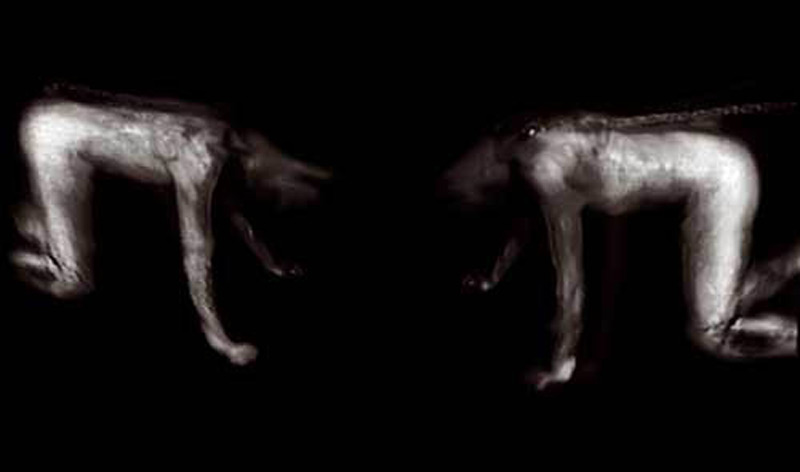Contemporary Chinese Art- another kind of view
DSL Collection
Chien man
More information on the works
More information on the works
Du Zhenjun, Chienman, Installation multim?dia interactive, 1997
"On touching the screen a partly human and partly dog-like figure splits into two identical halves, which are chained to some point outside the installation?s surface. These replicated bodies immediately start growling and biting at each other. When further touching the screen, a fight of the personality-split character against his other self breaks out, using a seemingly indefinite combination of martial-arts movements.
The viewer is further drawn into participation, as one first has to press a pedal to start the animation. This and the presumed influence on the fight via touch screen evokes a notion of control in the onlooker that is two times illusory: a hand to hand fight can?t be controlled from outside, such is nearly impossible for the combatants themselves - the ?fight simply is the way it is? as the saying goes - and the animation appears to be a dynamic unfolding of physical action. Nothing could be less ?true?. In fact what is seen on the screen merely ?is? one possible form of representing pre-arranged images, which the artist thought out, digitalized and programmed into a computer to finally have them visualised on a screen. If the artist chose otherwise, the representation could be in any form of displaying a binary code instead of showing moving images, e.g. endless rows and columns of numbers or even sound. Not much control for the viewer here either.
As ambiguous as the representational level is the work?s title. Chienman comes as a hybrid yet inexistent Anglo-French word. The levels of meaning can be further broken down to a phonetic one that nevertheless is also visually enforced: at a quick glance and by careless reading Chienman easily recalls sound and writing of ?Chinaman?. When realizing that Chien has to be understood as the French word for ?dog? another association is stimulated. The saying goes that in pre-1949 years a sign had been hanging at the gate of the little park at the end of the Bund in Shanghai that said ?No dogs and Chinese allowed?. Though such a sign never existed, the multiple uncertainties of this digital installation might tell us something about an ex-Shanghai artist who left the relative security of an academic employment at home for an existence as a free artist, living the life of a visually recognizable alien in a culturally diverse society while abandoning his training as a traditional painter in order to make art in a totally novel medium that not even today is accepted beyond doubt in the art world. The perceived but non-existent control of the viewer over the unfolding of the artwork may correlate with the loss of control of the artist, who is consciously making non-nation/culture based - i.e. non-Sino-centred - art at a time when everybody is looking for just that. "
Christof Buettner
"On touching the screen a partly human and partly dog-like figure splits into two identical halves, which are chained to some point outside the installation?s surface. These replicated bodies immediately start growling and biting at each other. When further touching the screen, a fight of the personality-split character against his other self breaks out, using a seemingly indefinite combination of martial-arts movements.
The viewer is further drawn into participation, as one first has to press a pedal to start the animation. This and the presumed influence on the fight via touch screen evokes a notion of control in the onlooker that is two times illusory: a hand to hand fight can?t be controlled from outside, such is nearly impossible for the combatants themselves - the ?fight simply is the way it is? as the saying goes - and the animation appears to be a dynamic unfolding of physical action. Nothing could be less ?true?. In fact what is seen on the screen merely ?is? one possible form of representing pre-arranged images, which the artist thought out, digitalized and programmed into a computer to finally have them visualised on a screen. If the artist chose otherwise, the representation could be in any form of displaying a binary code instead of showing moving images, e.g. endless rows and columns of numbers or even sound. Not much control for the viewer here either.
As ambiguous as the representational level is the work?s title. Chienman comes as a hybrid yet inexistent Anglo-French word. The levels of meaning can be further broken down to a phonetic one that nevertheless is also visually enforced: at a quick glance and by careless reading Chienman easily recalls sound and writing of ?Chinaman?. When realizing that Chien has to be understood as the French word for ?dog? another association is stimulated. The saying goes that in pre-1949 years a sign had been hanging at the gate of the little park at the end of the Bund in Shanghai that said ?No dogs and Chinese allowed?. Though such a sign never existed, the multiple uncertainties of this digital installation might tell us something about an ex-Shanghai artist who left the relative security of an academic employment at home for an existence as a free artist, living the life of a visually recognizable alien in a culturally diverse society while abandoning his training as a traditional painter in order to make art in a totally novel medium that not even today is accepted beyond doubt in the art world. The perceived but non-existent control of the viewer over the unfolding of the artwork may correlate with the loss of control of the artist, who is consciously making non-nation/culture based - i.e. non-Sino-centred - art at a time when everybody is looking for just that. "
Christof Buettner

